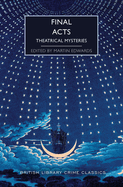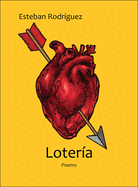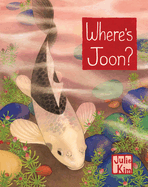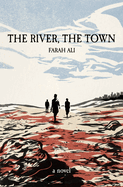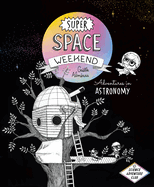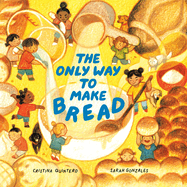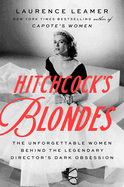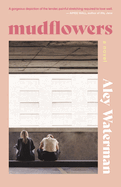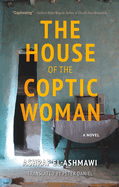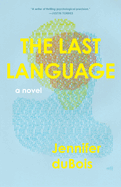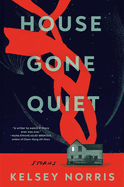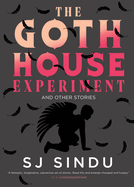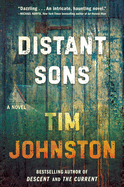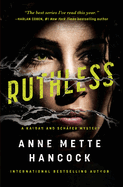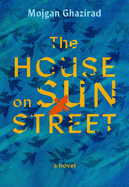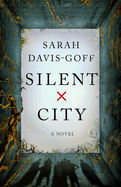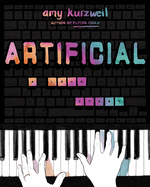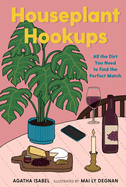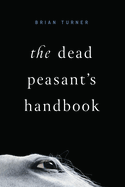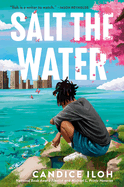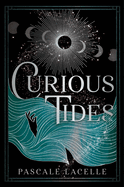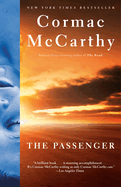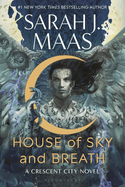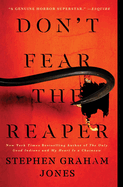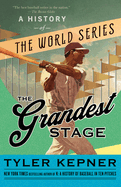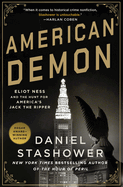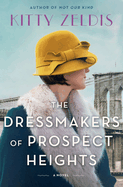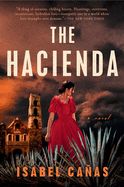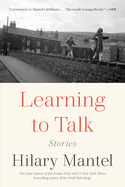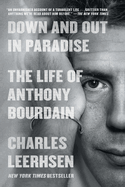Friday, October 20, 2023
This week's line-up includes a pair of stellar poetry books: Lotería by Esteban Rodríguez, inspired by the traditional Mexican game of chance played with a deck of 54 cards, resulting in "a creative, poignant recounting of his Mexican American family history"; and Brian Turner's stirring Dead Peasant's Handbook--the final book in "an intimate autobiographical trilogy" that offers love as the antidote to loss and conflict. Plus Where's Joon? by Julie Kim, which reunites the trio from Where's Halmoni? for another "visually spectacular adventure." And so many more!
In The Writer's Life, Isle McElroy discusses a book that "resonates deeply" with their own People Collide, and a professor whose love of a book changed them as a writer and reader.
The River, the Town
by Farah Ali
Farah Ali follows her lauded story collection, People Want to Live, with a first novel, The River, the Town, that shares similar aspects of spare, unblinking incisiveness. Moreover, it is delivered in three distinct voices covering three decades, with results not unlike reading interlinked short stories. These multiple perspectives form an intricate narrative, further complicated by unreliable characters.
In 1995, Baadal is a 15-year-old student growing up in the Town that "is considered part of the City." Their Town, however, is suffering: the River, its life source, was once "wide and deep" but has shrunk to "a thin stream flowing weakly over the ground." Hunger and heat are a daily provocation. The early death of his two younger sisters has made Baadal a disdained only child. His mother, Raheela, is "sharp and thin as a knife," and just as cutting; his father just turns away from her relentless abuses. Baadal finds solace away from home, first with his two closest buddies, and later with an older woman, Meena, who will eventually become his wife.
While Ali deftly builds her narrative arc around Baadal's challenging coming of age into troubled young adulthood, she also questions Baadal's experiences and memories in chapters that allow the two most important women in his life--Raheela and Meena--to speak.
Climate disasters threaten the globe. Communities can splinter anywhere. Families in crises are ubiquitous. In this teeming maelstrom of (in)humanity, Ali posits a wrenching, everyman tragedy that shrewdly reads as prophetic warning, nimbly cast in potent storytelling. --Terry Hong, BookDragon
Discover: Farah Ali's impressive first novel reveals an unnamed town in crisis--its climate, its communities, its people--through the coming-of-age of an abused teen growing into crushing adulthood.
Mudflowers
by Aley Waterman
Aley Waterman's sensitive first novel, Mudflowers, follows a young woman exploring intimacy, biological and built families, and art. A love triangle twists and reshapes itself, with both trauma and revelation. "I wanted so badly to love in a good way," says Sophie, the protagonist and narrator, 27 years old and a Newfoundland native who recently moved to Toronto, where she lives with a misogynistic writer and her best friend since childhood. He is a beautiful man named Alex who is also her on-and-off lover. Sophie sees Maggie reading her poetry at an event and is immediately swept away. Maggie is talented and enigmatic, "with big eyes full of wide highways." The two become close friends and, sometimes, lovers.
Sophie creates glass mosaics for wealthy patrons, Maggie writes, and Alex works on indie films. They are young artists scraping together livings in a big city, taking drugs amid art events and the bar scene. They slide frankly and openly in and out of sexual relationships. Sophie obsesses over her mother's death. Alex's mother left when he was 12, their parallel losses an unspoken understanding. The addition of Maggie to their close relationship, forming a trio, acts as a magnetic force that both imbalances and strengthens the bond. Secrets surface, and the balance shifts again.
Mudflowers follows Sophie to an artist colony at a castle in France and eventually home to Newfoundland. Place is important to this thoughtful protagonist, who is given to contorted philosophic musings. "[W]as it how beauty was directed or how it was received that was most important?" she ponders. Mudflowers is thought-provoking, expansive, and raw. --Julia Kastner, librarian and blogger at pagesofjulia
Discover: In this reflective debut, young artists in Toronto form a love triangle with both transcendent and painful results for all.
The House of the Coptic Woman
by Ashraf El-Ashmawi, transl. by Peter Daniel
Egyptian author and judge Ashraf El-Ashmawi (The Lady of Zamalek) reunites with Egypt-based translator Peter Daniel for The House of the Coptic Woman, another intricate legal drama. Two disparate narrators--a public prosecutor and a brutalized runaway woman--take turns relating the events in Upper Egypt, where religion-driven politics engender antagonism and violence. Nader Fayez Kamal leaves Cairo for remote Tayea, where he's been posted to the Ministry of Justice "with no advanced warning." He's greeted at his lodging by enigmatic caretaker Ramses, who acts as Nader's unofficial guide to interfacing with the majority Coptic and aggressive Muslim inhabitants. Nader is not the only stranger here; Hoda Yusef Habib seeks refuge in Tayea, fleeing her savage husband whom she left in a pool of blood, defending herself from his latest vicious attack. Hoda's survival is defined by acts of desperate resilience: as a child, her stepfather raped her; her mother discarded her; and even now, she narrowly escapes being drugged and assaulted when she begs for shelter at a mosque. Nader and Hoda's trajectories intersect, setting in motion inflammatory tragedy.
References to the 21st century and Hosni Mubarak mark El-Ashmawi's fiction as contemporary, but the legacy of the former autocratic president whose term ended in 2011 also underscores an ineffectual legal system and extreme gender inequity. Still a youthful idealist, Nader staunchly believes--at first--that he can and will enforce laws and enact justice; that he carries a gun without bullets seems to emphasize his impotent reality. Among the many he can't protect is Hoda. El-Ashmawi's fiction proves to be a sobering exposé of the multilayered abuses of ominous power. --Terry Hong, BookDragon
Discover: Ashraf El-Ashmawi's intricate novel reveals the consequences of religious clashes in rural Egypt through the perspectives of an idealistic public prosecutor and a brutalized wife seeking refuge.
The Last Language
by Jennifer duBois
The Last Language by Jennifer duBois (A Partial History of Lost Causes; Cartwheel; The Spectators) is an utterly compelling puzzle of linguistics, perspective, and some version of love. Angela is 27 years old when her husband dies suddenly; she is four months pregnant and has a four-year-old daughter. Just months later, she is kicked out of her Ph.D. program in linguistics at Harvard, following a nasty exchange with her "intellectual rival and personal archnemesis." With her daughter, Angela moves in with her mother and takes a low-paying job running an experimental therapy for "facilitated communication" to help nonspeaking patients with motor impairments. This questionable opportunity will have profound consequences. Readers gradually become aware that Angela is writing her first-person narrative while incarcerated. She tells of her love affair with a young man who can communicate only through Angela herself. Or, if readers do not believe her account, she has taken egregious advantage of a seriously disabled man.
Angela's background in linguistics gives her a complex, many-layered perspective on Sam O'Keefe's ability to communicate and even to think. Despite early reservations, she is quickly taken with Sam's sardonic humor, the life behind his startling eyes, his wit and intelligence--at least according to her account. Angela is ardent. She makes poor decisions, but her love is pure. Together, she and Sam read Nabokov: Pale Fire rather than Lolita, but the parallels present themselves. Backed by Angela's academic scholarship and the philosophy of what constitutes humanity, The Last Language is a smart intellectual riddle and a mystery with the highest of stakes. Readers will find it unforgettable. --Julia Kastner, librarian and blogger at pagesofjulia
Discover: A Harvard-trained linguist enters into an intimate relationship with a nonverbal man in this riveting riddle of a novel.
House Gone Quiet
by Kelsey Norris
In House Gone Quiet, a vivacious collection of 10 short stories, debut author Kelsey Norris contemplates loss, violence, and cultural clashes in settings that include the contemporary South and dystopian landscapes. With "The Sound of Women Waiting," the collection opens on a postwar scene where women--the spoils--are carried across the border in government trucks, "swaying like one weeping mass of sea grass." News and rumors spread of them enacting revenge on their new husbands. "Salt," likewise, employs a shifting perspective to ponder women's power in dystopian states. Alleen's spells are thought to ease death or safeguard pregnancies, but even she won't make the rains come to the dusty salt pan.
Two highlights, "Decency Rule" and "Such Great Height and Consequence," set up playful speculative scenarios. In the former, the mayor decrees that no one is to wear clothes anymore, and society splits into factions: those who adhere to the nudity order and those who resist. Norris imagines that the law finds backing from unexpected quarters. In the latter story, the town of Aberdeen removes a Confederate statue and gives people a chance to take a turn occupying the empty pedestal. It comes to be seen as a form of volunteering, or even a civic duty, and attracts all manner of amusing performances and confessions.
The sheer variety of genres, settings, and subjects means that the collection resembles a tasting menu--a showcase of the range of this debut writer. It will be exciting to watch her talent develop. This is perfect for fans of Danielle Evans. --Rebecca Foster, freelance reviewer, proofreader and blogger at Bookish Beck
Discover: Kelsey Norris's enticingly varied debut collection of 10 stories moves between the contemporary South and dystopian landscapes to consider themes of guilt, loss, racism, and women's power.
The Goth House Experiment
by SJ Sindu
Creepy, vibrant, dark, and even funny, The Goth House Experiment spotlights Lambda Literary Award finalist SJ Sindu's skill with the short story form. These half dozen stories are rich with social commentary, layered and keenly observed.
The character Amit's story, "Patriots' Day," isn't solely about anti-Asian violence. It's also about the slow decay of a marriage, and the pressures of changing circumstances on a formerly illicit relationship. And it's about gendered and age-based workplace discrimination, and the multitude of smaller ways in which people hurt each other.
Many entries are set firmly in time or place, but Sindu turns them timeless with a focus on the characters' complicated internal lives. The couple in "Wild Ale" grapples with the Covid-19 pandemic as everyone goes slightly mad, including the main character, who obsesses over home-brewing projects and strains on their finances and relationships: "Maybe this pandemic has made us all into assholes. At the very least, it's made us into cornered animals, hissing and spitting at the faintest shadows."
Sindu's artistic range is also on display in the titular "Goth House Experiment," in which three creative people share a home, and one spins into madness fueled by grief, the specter of Oscar Wilde, and fentanyl. Like Sindu (Blue-Skinned Gods), many of the central characters are South Asian or queer, and the author portrays them with the complexity and diversity of human experience. Sindu invites readers to examine and ultimately accept these characters as they are: narcissistic, loving, unfaithful, righteous, greedy, kind, bigoted. There are no convenient endings here, but readers won't need them. Sindu's characters are terrible, wonderful, and, most of all, human. --Suzanne Krohn, librarian and freelance reviewer
Discover: Wide-ranging and incisive, this dark and moody collection of six short stories will thrill fans of Carmen Maria Machado's Her Body and Other Parties.
Mystery & Thriller
Final Acts: Theatrical Mysteries
by Martin Edwards, editor
Forget the butler: the dresser did it. Not necessarily, but dressers--stage actors' best friends--are on the scene for a suspiciously large number of murders in the impeccably written and hair-raising British Library Crime Classics collection Final Acts: Theatrical Mysteries, edited by series consultant Martin Edwards (The Golden Age of Murder; The Puzzle of Blackstone Lodge).
The book's 14 theater-set stories date from 1905 to 1958, overlapping with the golden age of detective fiction and reinforcing its fine reputation. In Marguerite Steen's "In View of the Audience" (1934), a man who has taken the wrong train meets a fellow rider who invites him to come see his recently purchased theater, which has a dark history: there was once a murder onstage that the audience thought was part of the show. In Brandon Fleming's "The Wrong Make-Up," a theater actor with a slew of enemies mysteriously takes ill and dies in his dressing room, his face grotesquely plastered with stage makeup.
In several stories, someone is disguised by a costume; as Edwards points out in his introduction, the identity-concealment possibility offered by an actor's stage dress can't help but make the theatrical setting attractive to crime writers. Another appeal: as the chief constable in Roy Vickers's "The Lady Who Laughed" (1948) learns, probably the hard way, "Actors never betray themselves with involuntary movements of body, hands or face." And in Dorothy L. Sayers's "Blood Sacrifice" (1936), it's noted that death is simply "good theatre." So is Final Acts. --Nell Beram, author and freelance writer
Discover: Fourteen mysteries dating from 1905 to 1958 make up this impeccably written and hair-raising theater-set collection from the British Library Crime Classics series.
Distant Sons
by Tim Johnston
Boys and young men don't fare well in the small, struggling town on the Wisconsin side of the Mississippi River in Tim Johnston's eloquent and riveting Distant Sons. Three boys disappear in three consecutive years in the 1970s; afterward, a 15-year-old hangs himself. Marion Devereaux, now an old man, has been an outsider since the day he came to live with his grandmother and uncle when he was 11 years old. As one character astutely observes, "this place is not so kind to its sons."
When his truck breaks down, carpenter Sean Courtland drifts into town with no real plan. His presence causes the past and the present to intersect, changing the course of several lives. Soon after arriving, he gets in a bar fight with a man who is harassing waitress Denise Givens, whom Sean, in the melee, hits by accident. Not only does she not press charges but the two begin a wary relationship, while she takes out a restraining order against the other man. To fix his truck, Sean takes on a carpentry job for Devereaux, now a recluse whom townspeople avoid. He was long suspected in the disappearance of the three boys, even though no evidence surfaced. Sean also becomes friends with drifter Dan Young, who also begins work on the Devereaux house. Johnston (Descent) expertly crisscrosses these lives in a poignant novel that is both character-driven and action-packed. Distant Sons is about people rising to challenges they never expected. --Oline H. Cogdill, freelance reviewer
Discover: A drifter's presence in a small town on the Mississippi River causes the past and present to intersect in this riveting, character-driven thriller.
Ruthless
by Anne Mette Hancock, transl. by Melissa Lucas
"You're a journalist and he's a policeman. Oil and water," the Copenhagen Police Department's Detective Sergeant Erik Schäfer tells Heloise Kaldan--his explanation for why she's not getting any information out of a cop. And yet Kaldan and Schäfer make a remarkably simpatico crime-fighting duo, having joined forces in The Corpse Flower, The Collector, and now Ruthless; Melissa Lucas translates this third novel in Anne Mette Hancock's top-shelf series.
Kaldan has long seen Schäfer as a father figure, and now she also finds herself gravitating toward Jan Fischhof, a 60-something cancer sufferer; she intends to write a profile on the hospice that's seeing him through his last days. During one visit, Fischhof seems to want to get something off his chest, although his dementia makes him hard to understand. After he becomes agitated when Kaldan mentions his adult daughter, she has Schäfer search for a name that Fischhof uttered. What Schäfer unearths brings Kaldan to Southern Jutland, where a case concerning one missing teenage girl soon becomes two. Ruthless concludes with a twist that only a clairvoyant would see coming.
As ever, Hancock is as attuned to Kaldan and Schäfer's personal lives as she is to the crimes they're investigating. While Kaldan gets reacquainted with an old lover in Southern Jutland, Schäfer frets about the toll his advancing years may be taking on his marriage and professional life. As Kaldan and Schäfer work together, albeit geographically apart, Ruthless becomes a portrait of friendship, loyalty, and other qualities contrary to the title of this impression-making novel. --Nell Beram, author and freelance writer
Discover: In the third novel in the top-shelf Kaldan and Schäfer crime series, Copenhagen journalist Heloise Kaldan goes to Southern Jutland after learning something harrowing about a dying man's past.
The House on Sun Street
by Mojgan Ghazirad
The House on Sun Street, a beautifully written coming-of-age novel, affectionately presents the journey of a girl narrator navigating the complexities of life in revolutionary Tehran. Author Mojgan Ghazirad's debut novel is a polished gem for readers across age groups, those going through adolescence now as well as those for whom it is a more distant memory. The protagonist Moji tells this story; her world during her childhood and adolescence is anchored in the classic One Thousand and One Nights, which her grandfather Agha Joon reads to her. The stories provide stability for Moji and Mar Mar, her younger sister, as their father, who has been serving in the shah's military, departs the country for the United States. Eventually, after an extensive international search for visas, Moji, Mar Mar, and their mother are able to join him. But turmoil follows them in the form of the Iranian hostage crisis back in Tehran: "It seemed as if an evil ifrit had cast a dark spell on our life in America." After a year of increasing isolation, they return to Iran.
Although reuniting with their family is joyful, almost everything has changed, most of all in the role of women, which Moji and her sister are fast becoming. It seems things that Moji loves most--reading, her friend Nusha, and the enigmatic librarian Shirin--hold hidden threats in the new world of Iran. The House on Sun Street is an unforgettable journey through history, the pains of growing up, and the power of storytelling. --Elizabeth DeNoma, executive editor, DeNoma Literary Services, Seattle, Wash.
Discover: The House on Sun Street is a tender reminiscence of a girl in a tight-knit, loving family who comes of age amid the tumult of revolutionary Tehran.
Murder by Degrees
by Ritu Mukerji
Ritu Mukerji's atmospheric debut novel, Murder by Degrees, follows a quick-witted female physician trying to solve a missing persons case--or is it murder?--in 19th-century Philadelphia. Dr. Lydia Weston has a full schedule: she instructs female medical students at the Woman's Medical College of Pennsylvania and also treats working-class patients at a neighborhood clinic. Lydia is concerned when Anna, a young chambermaid with an interest in education whom Lydia has befriended, goes missing. But her concern turns to dread when a young woman's body is pulled out of the river, with Anna's clothing and possessions nearby. Determined to find the killer and feeling guilty that she didn't act sooner, Lydia joins the police investigation (to the chagrin of the sergeant assigned to the case) and is quickly drawn into a web of secrets and danger.
Mukerji, herself a physician, describes Lydia's anatomy lessons and her visits to various medical facilities in exacting detail. Her keen observational eye extends to her characters' habits: readers will learn much about the dress, architecture, and mores related to various social classes in 1870s Philadelphia. As the case grows more complicated, Lydia turns to trusted sources for advice, including an elderly local bookseller who shares Lydia's penchant for poetry. The words of several contemporary poets, including Walt Whitman and Emily Dickinson, aid Lydia's musings as she tries to find the killer. A dramatic turn of events leads both Lydia and readers to a surprising conclusion.
This engaging, incisive, and well-plotted historical mystery introduces readers to an unforgettable protagonist and her place in a rapidly changing world. --Katie Noah Gibson, blogger at Cakes, Tea and Dreams
Discover: Ritu Mukerji's engaging and well-plotted debut novel follows a female physician trying to solve the murder of a young woman in 1870s Philadelphia.
Science Fiction & Fantasy
Silent City
by Sarah Davis-Goff
Sarah Davis-Goff's Silent City centers on a young woman faced with impossible choices in a post-apocalyptic version of Dublin. "To me, banshees are heroes. I saw images of banshees growing up at home on the island, women dressed in black, warriors. The ones who fight the skrake. HERE TO PROTECT, the grimy posters said." Orpen was raised by her two mothers on an island devoid of other humans and, crucially, of skrake: monsters that bite, infect, and kill. Following the death of her mothers, Orpen ventures into a world she knows nothing about. She is bent on survival in this terrifying landscape of zombie-like beasts.
In the dystopian city that was once Dublin, she becomes a banshee, a member of the entirely female troops of paramilitary security forces ostensibly meant to protect, but actually used by "management" (entirely male, sinister, self-serving) to forage for supplies and keep other lowly citizens in check. Wallers work night and day, repairing and rebuilding the city's walls against the skrake; the roles of farmers and breeders are equally humble. Banshees work in pairs: Orpen has found a surreal closeness and loyalty with her partner: "I never saw a woman who wasn't sometimes beautiful, but Agata always is."
The zombie apocalypse represents a possibly overdone subgenre, but Davis-Goff (Last Ones Left Alive) takes her readers into fresh territory here. Silent City is grim but hopeful, tackling questions of risk, trust, courage, morality, and sacrifice. Davis-Goff's prose is stark but lovely. A strong feminist voice, austere circumstances, and a resolute sense of integrity make this dystopia memorable and inspiring. --Julia Kastner, librarian and blogger at pagesofjulia
Discover: In this darkly atmospheric novel set in a futuristic Dublin, a young woman fights for justice in an oppressive society ruled by fear during a zombie-like apocalypse.
Romance
Love Interest
by Clare Gilmore
Oomph and moxie infuse Clare Gilmore's Love Interest, a spunky contemporary workplace romantic comedy. Gilmore sets the story in a massive business conglomerate, based in Manhattan, which promotes trendy iconic brands. Casey Maitland is a 24-year-old financial analyst, one of many "white-collar workaholics," who resides in Brooklyn Heights by way of Nashville, her hometown. She works for Little Cooper Publications, a division of the company where she focuses on "crunching numbers and pleasing corporate executives." After her boss encourages her to apply for a promotion, a project manager position, her ambitions go bust: Casey loses out on the new gig to Alex Harrison, a hip, handsome, Harvard-educated, and hard-working Korean American, the son of the board chairman and the same guy she'd just admired on a flirty elevator ride. Soon, she is working alongside him on a new project. Nepotism initially tests their wills, until they find common ground amid familial complications. Can the two actually join forces and merge on the road to success? Or will cut-throat corporate politics--and a search to find deeper meaning in their respective lives--drive them apart?
Casey's snarky internalized narrative voice will win over readers; she is both analytical and competitive, yet sensitive and vulnerable, at her core. This, along with a diverse cast, lots of romantic chemistry, authentic corporate angst, and spot-on details about the appeal of living and working in New York City, will have rom-com readers falling headlong for this swoon-worthy, feel-good first novel. --Kathleen Gerard, blogger at Reading Between the Lines
Discover: Love Interest is a smart, hip rom-com about two white-collar workaholics whose competitive nature helps them discover what they truly want out of life.
Graphic Books
Artificial: A Love Story
by Amy Kurzweil
Cartoonist Amy Kurzweil (Flying Couch) returns to graphic memoir with Artificial: A Love Story, a thought-provoking examination of family and identity, artificial intelligence, and the nature of creativity.
The narrative itself focuses on three main components: Kurzweil's relationship with her partner, Jacob; the artist's father, famed futurist and writer Ray Kurzweil's effort to reanimate his father, Fred Kurzweil, through an AI chatbot built from his father's writing; and Fred, a pianist and conductor whose musical talent made possible his escape from the Nazis and passage to the United States. All three generations are remarkably creative, and all three are what Kurzweil calls "documenters," those who strive to hold on to information and make sense of it. Of her father, Kurzweil says, "he became an inventor not only to record human affairs, but to change them. As he says, every question needs an answer; and every problem, a solution." With his work in computer science and the Singularity ("a period of profound cultural and evolutionary change in which computers will outthink the brain and allow people... to live forever"), Ray Kurzweil knows plenty about changing human affairs and answering impossible questions, and readers will be intrigued with this timely and fascinating look behind the scenes. But even those with little interest in AI will connect with the desire to feel known and loved, across time and distance and even across generations.
Artificial is a wide-ranging and intellectual memoir, one that insists on the growth that comes through uncertainty. --Sara Beth West, freelance reviewer and librarian
Discover: Artificial: A Love Story uses thought-provoking concepts of artificial intelligence and machine learning to explore big issues: family and identity and the nature of creativity.
Biography & Memoir
Hitchcock's Blondes: The Unforgettable Women Behind the Legendary Director's Dark Obsession
by Laurence Leamer
Alfred Hitchcock did hire brunettes as the female leads in his movies--Joan Fontaine in Rebecca (1940) and Suspicion (1941), for starters--but it can't be coincidence that the vast majority of his leading ladies were blondes. Laurence Leamer (The Price of Justice; Capote's Women) explores this apparent fixation in the entrancing Hitchcock's Blondes: The Unforgettable Women Behind the Legendary Director's Dark Obsession, which presents the Master of Suspense's predilection as the sort of fetish that could be found at the center of one of his films.
Leamer profiles eight blondes who received top billing in 14 of Hitchcock's most highly regarded films. First up is June Howard-Tripp, star of The Lodger (1927), in which, Leamer writes, "for the first time, [Hitchcock] revealed his passion for blondes and his pleasure in making them suffer." The roundup concludes with Tippi Hedren, who starred in both The Birds (1963) and Marnie (1964). Of Hitchcock's casting choice Leamer writes, "he envisioned [Hedren] as one of his classic blondes, her coolness hiding a smoldering sexuality."
Unlike the director, Leamer is evenhanded with Hitchcock's leading ladies. As Leamer tells each actress's story, Hitchcock usually comes across as a friendly colleague, but occasionally he's closer to a creepy uncle. (Leamer is attuned to the sea change in thinking about predatory sexual behavior since Hitchcock's day.) Hitchcock's Blondes is more than a valuable exploration of Hitchcock's casting choices: it charts the personal shortcomings of a great director who seems not to have been such a great man. --Nell Beram, author and freelance writer
Discover: This entrancing study presents the Master of Suspense's predilection for blondes as the sort of fetish that could be found at the center of one of his films.
Political Science
Wrong: How Media, Politics, and Identity Drive Our Appetite for Misinformation
by Dannagal Goldthwaite Young
Misinformation has been a topic of increasing concern in recent years, and in Wrong: How Media, Politics, and Identity Drive Our Appetite for Misinformation, Dannagal Goldthwaite Young (Irony and Outrage) examines the unique cultural structures in the United States that make its citizens particularly susceptible. Young, a professor of communications and political science, takes a reasoned, academic approach to the topic but does so in a mostly accessible manner, making this title appropriate for lay readers. Using the U.S. political and social landscape as a lens, Young argues that a person's need to comprehend the world, feel control over their surroundings, and connect with their community (what she calls the three "C"s) drives the formation of mega-identities, which are then reinforced by journalism and social media outlets.
Alignment with these mega-identities causes people to believe things that evidence does not support, and Young hopes greater understanding might disrupt the tendency to act on those misperceptions. Young, strongest in her explication of in-group norming, notes the inclination to share false narratives, "as if to say, 'How do people like us process something as confusing and difficult as this?' " Though trying for an unbiased perspective, the book struggles as it highlights examples drawn primarily from one side of the political divide, leaving readers to wonder if it will reach a broad enough audience to have its desired impact. Still, it offers valuable insight and works to strengthen democracy and the social connectedness still possible in the United States. --Sara Beth West, freelance reviewer and librarian
Discover: Media and politics expert Dannagal Goldthwaite Young elucidates the susceptibility to misinformation and how to combat it.
Gardening
Houseplant Hookups: All the Dirt You Need to Find the Perfect Match
by Agatha Isabel, illus. by Mai Ly Degnan
Agatha Isabel's Houseplant Hookups is the perfect book for people whose brown thumbs have let many a plant die. Clear explanations, a friendly tone, and lots of humor ease plant-shy readers into trying for plant love again. Isabel begins with tips for choosing a plant and maintaining a relationship, including self-reflection and assessment of lifestyle, needs, and areas of possible compromise. The main portion of the book is organized as dating profiles for specific plants. Each one-page profile begins with basic information about the plant's light, water, humidity, and temperature needs, as well as a difficulty rating. Information about the plant is provided through answers to common dating app prompts, like "My best feature is..." and "The key to my heart is...." This provides a quick and fun assessment of the plant's match factor with a person's home environment and lifestyle. If browsing profiles don't help readers decide, they can take the "Plant-Based Personality Quiz" for the plants Isabel suggests as good matches for their results. An index with plants organized by levels of difficulty and needs also lets readers find plants to fit their specific situation.
Houseplant Hookups is a great plant guide, but it's also a really fun read. Isabel makes many references to pop culture, including popular hashtags. The dating angle adds the right touch of whimsy without overwhelming the topic itself, and Mai Ly Degnan's illustrations allow readers to visualize the plants in a variety of home settings. --Dainy Bernstein, postdoc in children's literature, University of Illinois Urbana-Champaign
Discover: No matter how many gardening failures readers have, this book rekindles plant passion and gently guides them in building successful plant relationships.
Poetry
Lotería
by Esteban Rodríguez
Lotería is a traditional Mexican game of chance played with a deck of 54 cards depicting various nouns. Esteban Rodríguez's eighth collection, Lotería (part of the Sabine Series in Literature for Louisiana and Texas writers), allots each Spanish-language card a one-page poem in a creative, poignant recounting of his Mexican American family history.
Rodríguez (Limbolandia) invites readers into his family circle through the use of the second person. The poems spin stories about different relatives in turn. Both parents made the perilous trek from Mexico. "Like your father, your mother/ never speaks of her crossing,/ so you invent a narrative for her,/ switch the river for a desert,/ add a scene with carrion and carcasses,/ with cactuses adorned with torn shirts." The cover image is from "27 El corazón," which imagines his father's pierced heart being too big for his chest. One cousin teases that a swallowed watermelon seed will fruit in Rodríguez's belly ("28 La sandía"); another prepares to go to war in 2007: "seated in the middle of your uncles,/ aunts, your cousin smiles, babysits/ a Bud Light because he can,/ because nineteen is just a number,/ and his deployment is near."
Alliteration and internal rhymes create aural impressions; animals, foodstuff, and household objects are the metaphorical stock. The sun-moon pair, "23 La luna" and "46 El Sol," is a highlight. The poet memorializes his father's hard labor, alluding to the Atlas myth and describing his versatile work boots. The familial struggle for survival has buoyancy in Rodríguez's telling. --Rebecca Foster, freelance reviewer, proofreader and blogger at Bookish Beck
Discover: With 54 poems corresponding to the 54 cards of a traditional Mexican game of chance, Esteban Rodríguez delivers a creative, poignant recounting of his Mexican American family history.
The Dead Peasant's Handbook
by Brian Turner
In Brian Turner's clear-eyed The Dead Peasant's Handbook, love is the key to surviving bereavement and wartime trauma. The collection, formatted in four thematic sections, is Turner's fifth poetry collection and the final installment--after The Wild Delight of Wild Things and The Goodbye World Poem--in an intimate, autobiographical trilogy. Part I, "On War & Conflict," depicts the lasting effects of cyclical violence: "What they don't tell you about war/ is how it outlives us." "Sunflowers," referencing Russia's military aggression against Ukraine, acknowledges that economic considerations can outweigh ideology: "a bank ledger/ might shape a decision tree./ The price of fuel. Sunflower oil." Collateral damage is wide-ranging, including Scottish-island sheep and the Bamiyan Buddhas, to whom the poet gives imaginative voice. Turner presents Part II, "On Dream," in the multi-part "Metal Fume Fever," which employs anatomical and marine vocabulary. Part III, "On Love & Loss," commemorates the death of Turner's wife, Ilyse Kusnetz, using lines from her own poetry. The phrasing connects to the earlier poems about conflict: "What they don't tell you about love/ is how our bodies house the dead."
Turner varies his line lengths and stanza forms, and wields repetition as a rhythmic rhetorical strategy: alliteration and recurring horses and the looping sentences of "Call It Leaves and Rain" and "The Starry Starry Nights." The final section, "On Survival," contains alarming stories of a burning meth lab and a car accident. "All the Questions" marvels that Turner's sister fell from a plane and lived. Here, the weight of loss is counterbalanced by love and lucky breaks. --Rebecca Foster, freelance reviewer, proofreader, and blogger at Bookish Beck
Discover: The 29 poems of Brian Turner's stirring fifth collection--the final book in an intimate, autobiographical trilogy--offer love as the antidote to loss and conflict.
Children's & Young Adult
Where's Joon?
by Julie Kim
Julie Kim's enchanting Where's Halmoni? introduced older sister Jin (also called Noona, or big sister in Korean), younger brother Joon, and their Halmoni (grandmother), whose home contains a magic portal into a mythical world of Korean folktales come to life. The trio returns in Where's Joon?, to experience another visually spectacular adventure, enhanced by Kim's bilingual exposition.
"Halmoni! I can't find Joon ANYWHERE," Jin calls from the porch to her grandmother in the garden. "And there's a HUGE mess in the kitchen," she warns. Once inside, after confirming the confusion, Halmoni gets a call--not via the phone on the counter, but from her piscine messenger circling their vibrating fishbowl. Halmoni knows exactly what to do: before sending Jin to the magical other side, she must arm her tenacious granddaughter with enough rice cakes to appease Jo-harabuji, the hangry old man whose help Jin will need to bring Joon home.
Kim gleefully repeats the success of Where's Halmoni? by seamlessly integrating her own adaptations of "memorable Korean folktales and myths" that celebrate honesty, ingenuity, generosity, and perseverance. Throughout her main text, she blends both English (for the Korean American family) and untranslated Korean (for the mythical creatures they encounter). At story's end, a "What did they say?" double-page spread clearly reveals all that was expressed. Kim's story is absolutely enchanting, but her stupendously vivacious illustrations prove even more memorable. The author/illustrator imbues every scene with infectious energy, inviting readers to join in the clever challenges to bring the family safely back together. --Terry Hong, BookDragon
Discover: The charming sequel to Where's Halmoni? provides another mythic challenge for Korean American siblings Joon and Jin: get back in time to celebrate their beloved grandmother's birthday.
Super Space Weekend: Adventures in Astronomy
by Gaëlle Alméras, transl. by David Warriner
A trio of friends explore the wonders of space in Gaëlle Alméras's charming graphic nonfiction work for middle-grade readers, Super Space Weekend. Comic-style characters Squeak, Orni, and Castor spend a weekend in Squeak's treetop observatory discovering exciting facts, observing heavenly bodies, and coming away enamored with the mysteries beyond Earth.
Models, maps, illustrations, and diagrams grace many of the delightful, grayscale panels and double-page spreads. Squeak explains to their friends (and readers) the various elements of space and the tools used to examine and understand them: "Early telescopes used lenses to magnify the night sky. Modern telescopes use a system of mirrors instead." They also share facts about pioneers in the field, like the "Super Space Women," the first women in space from four different countries.
Alméras includes brilliant pops of color in her otherwise completely black-and-white work to enhance things such as the Northern Lights or a stellar nebula. The author/illustrator also employs relatable analogies, zestfully translated from the French by David Warriner, to help her audience grasp challenging concepts, like comparing the spiral Milky Way galaxy to a pizza: "Imagine the view you'd have if you were a slice of pepperoni!" And nestled into the information-filled pages are other little treasures, like a Darth Vader mask and trivia tidbits: "The term [Big Bang] was first used by physicist Fred Hoyle, who was poking fun at this theory on the radio in England" ("I'll never believe the universe was created in a big bang!"). Edifying and entertaining, this graphic work is likely to launch a love of outer space for many young minds. --Jen Forbus, freelancer
Discover: Three friends spend a fascinating weekend experiencing the wonders of space in this illuminating graphic nonfiction work.
The Only Way to Make Bread
by Cristina Quintero, illus. by Sarah Gonzales
Food nourishes life and helps us preserve traditions and build community. Cristina Quintero's cozy debut, The Only Way to Make Bread, illustrated in warm, comforting tones by Sarah Gonzales (Maribel's Year), portrays children experiencing both through food culture.
A large group of adults and children meet in a kitchen to bake, fry, steam, and grill a diverse range of breads for an afternoon picnic. Each type of bread is prepared by adults and children working together and involves much more than edible ingredients: specific cookware ("the pan can be heavy and round or tall and rectangular"), techniques ("maybe your dough is rolled into long strips and braided"), and textures ("some doughs like to bubble, some... are sticky and wet") are a few of the items noted in Quintero's direct text. The text and page turns mimic the easy-to-follow steps one would read in an actual recipe: "Get out your best wooden spoon or use your hands and knead it all together."
Quintero, a first-generation Colombian Canadian, aimed to "highlight the everyday joy that is created within immigrant communities" in this picture book. Gonzalez's mixed-media illustrations are dominated by an earthy palette in hues of green, brown, gold, and copper. The grainy depth of the colored-pencil shading creates a scrapbook aesthetic, like a vintage postcard collection. Backmatter includes helpful descriptions of bread types such as Jamaican Hardo and Indian Puri, as well as recipes for arepas and pandesal. The art, combined with Quintero's graceful text, results in a behind-the-scenes glimpse into the ordinary, love-filled lives of individuals from various cultures. --Rachel Werner, author and teaching artist at Hugo House, Lighthouse Writers Workshop, and The Loft Literary Center
Discover: The scrumptious tradition of bread making is revealed through the ordinary lives--and routines--of immigrants sharing a community kitchen in this instructive picture book.
Salt the Water
by Candice Iloh
Candice Iloh's Salt the Water is another lyrical coming-of-age novel in verse, following the success of Every Body Looking, a 2020 National Book Award finalist.
Cerulean is a Black, nonbinary high school senior in the Bronx, N.Y., counting the months until graduation. They're tired of being "stuck in stiff-ass classrooms" and "staring down out-of-touch white men/ who don't care if i really learn." Mr. Schlauss, who's "only got to survive one more year teaching/ inner-city youth" for Teach for America, relentlessly targets them, restricting even their ability to use the restroom during class.
Cerulean envies their brother, Airyn, who's able "to go to an Afrocentric Montessori school," because their hardworking parents could afford private education by the time he was born a decade after Cerulean. Still, their nurturing parents have created a welcoming home environment in which "all of us could have whatever/ we needed to keep becoming/... / ourselves." Cerulean is also blessed with a loving partner and a pair of best friends. The foursome dream of someday "living off the grid" together in California--until a tragedy shatters their plans, and Cerulean is forced to make impossible choices between family and autonomy.
Iloh writes with raw vulnerability, their sparse verses moving around the pages, as if refusing--like Cerulean--to follow unnecessary rules and expectations. While Iloh grants Cerulean priority, they deftly fill in (to an extent) what Cerulean has left unsaid or couldn't know through the voices of those who love them best. Iloh scathingly, affectingly indicts failing educational and societal systems that damage even the most resilient individuals. --Terry Hong, BookDragon
Discover: Candice Iloh's scorching novel-in-verse explores a nonbinary teen's desperate frustrations to be heard by adults determined to stifle their autonomy.
Curious Tides
by Pascale Lacelle
Complex world-building and original lunar lore help make this debut fantasy, the first in a planned duology, an impressive standout.
"Mousy" blonde-haired Emory Ainsleif, with "storm-colored" eyes, is a second-year student in House New Moon at Aldryn College for Lunar Magics. She is returning to school despite the horrific night last semester when she, best friend Romie, and seven other students went into the mystical sea cave called the "Belly of the Beast" to perform an arcane ritual. Emory--the sole survivor--washed ashore on the banks of the Aldersea with "a spiral burned in silver" on her wrist. Now, one of the eight students thought to have drowned that night four months ago washes back with the tide. As Emory calls on her Healer magic to help the nearly dead student, she accesses rare, new powers and enlists the aid of Romie's brother, Baz, to teach her how to control her magic. Eager to help is entitled, "dapper," chestnut-haired Keiren, a fellow student privy to surprising secrets. Emory, trying to understand the ritual and learn what killed her friend, is determined to find answers within Aldryn's secret, cult-like society.
Magic and an original mythology propel the engrossing dual narratives of Emory and Baz, each differently motivated but equally compelled to investigate Aldryn's dark underbelly. Ambition, power, magic for benevolent-vs.-selfish motives are all on display in this arresting and imaginative escape to a complex fictional world infused with tantalizing lunar magics. --Lynn Becker, reviewer, blogger, and children's book author
Discover: Complex world-building and original lunar lore help make Curious Tides an arresting and imaginative debut.
New in Paperback
The Writer's Life
Reading with... Isle McElroy
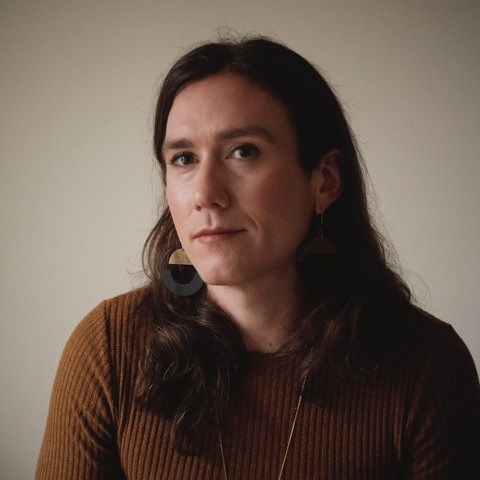 |
|
| photo: Jih-E Peng | |
Isle McElroy is a nonbinary writer living in Brooklyn, N.Y., whose debut novel, The Atmospherians, was named a New York Times Editors' Choice. Their writing has appeared in the New York Times, the New York Times Magazine, the Guardian, the Cut, Vulture, GQ, Vogue, the Atlantic, and Tin House. McElroy's second novel, People Collide (HarperVia, September 26), explores gender through the story of a husband and wife who switch bodies.
Handsell readers your book in 25 words or less:
People Collide is a continent-spanning magical realist novel about a husband and wife who trade bodies. It's funny. It's sexy. It's smart.
On your nightstand now:
I just finished--and thus removed from my nightstand--Catherine Lacey's first novel, Nobody Is Ever Missing. I've been a fan of Lacey's work for some time but had never read this novel. It's incredible, and it's been shocking to see how deeply the novel resonates with my own. Both are about a marriage coming undone, and the assumptions that partners make for each other. I love the spry curiosity and intelligence of Lacey's prose. I'll read anything she writes.
Favorite book when you were a child:
Confession: I didn't read that much when I was a kid. But when I did, I was obsessed with the Goosebumps franchise. At this point, I remember the titles more than I remember the plots of the books. But I have strong memories of green goo overtaking towns, and cameras that kill whoever poses for photos. Both of my novels have slight horror undertones, and I can't help but see these books as influences on my style as a writer.
Your top five authors:
Donald Barthelme, Deborah Eisenberg, Renee Gladman, Katie Kitamura, Robert Walser.
Book you've faked reading:
I don't know if this counts, but I've been halfway through The Magic Mountain for nearly a decade. I have told people that I've read it. And technically, I have read some of it, so that counts for something. But if anyone asks what happens after page 270, I won't be able to answer. I have, however, truly loved those first 270 pages every time I've given them a go--and, yes, it has been multiple times.
Book you're an evangelist for:
Helen DeWitt's The Last Samurai. I'm far from the only one who evangelizes this novel, but I really cannot get enough of it. It's so rare to write with such passion and intelligence--while also creating a gripping plot. I'm especially drawn to stories where characters are searching for someone important to them, and The Last Samurai, at its core, is a story of a boy looking for his father. The novel, however, is so far from sentimental. I can't recommend it enough.
 Book you've bought for the cover:
Book you've bought for the cover:
Lote by Shola von Reinhold. There is something very dignified about the cover, and the peacock at the center adds an air of mystery that made me extra curious about the book.
Book you hid from your parents:
This might not be the intention of the question, but I spent a few months hiding my first chapbook, Daddy Issues, from my father. I don't think I ever told him outright--he learned about the book because his partner saw something I posted online. There was nothing scandalous in the book, but I wasn't prepared to have a conversation with him about why I named a book Daddy Issues. Of course, he wanted to read it, and I was pleased to learn he didn't find it controversial at all. His takeaway: "This isn't about your daddy issues; it's about issues that dads have." We never spoke of the book again.
Book that changed your life:
It was probably Ernest Hemingway's The Sun Also Rises. I remember both loving the book and loving how I was taught to read it. I read it for the first time in a literary modernism class taught by a pretty old-school professor. But his love for the novel made it impossible to not love the novel. Hearing him talk about Hemingway's prose and vision--the passion and admiration in his voice--made me want to read the way that he read. That was a turning point for me as a writer and reader.
Favorite line from a book:
"One learns very little here, there is a shortage of teachers, and none of us boys of the Benjamenta Institute will come to anything, that is to say, we shall all be something very small and subordinate later in life."
This is the opening sentence of Robert Walser's Jakob von Gunten. It's about a boy who attends a butler academy where he is taught to be nothing. The novel was first published in 1909, but in its humor and tone, it feels very contemporary to me. It's one of my favorite books to reread. And the narrator's lighthearted self-doubt definitely helped shaped Eli's voice in People Collide.
Five books you'll never part with:
Sorry to Disrupt the Peace by Patrick Cottrell. Cigarettes by Harry Mathews. Dictee by Theresa Hak Kyung Cha. The Collected Stories of Deborah Eisenberg. Calamities by Renee Gladman.
Book you most want to read again for the first time:
Proxies by Brian Blanchfield. I read this book when it first came out and was completely blown away. I've been scared to reread it for that reason. Proxies is a collection of essays where Blanchfield relies entirely on memory, even when it means getting things wrong. There is an appendix noting his errors, but the pleasure of the book comes from the essays that precede the appendix, existing in that space where everything he says may or may not be true.
Your five favorite new(ish) books:
Wolfish by Erica Berry; Nevada by Imogen Binnie; I Do Everything I'm Told by Megan Fernandes; Pricks in the Tapestry by Jameson Fitzpatrick; Mother in the Dark by Kayla Maiuri.
Book Candy
Book Candy
Wraith, for example. Merriam-Webster shared the history behind 8 Halloween words.
---
"Watch a strange animation of Edgar Allan Poe's 'Tell-Tale Heart,' voted the 24th best cartoon of all time (1953)." (via Open Culture)
---
The New York Public Library recommended "bewitching romance books for spooky season."
---
For Halloween, Mental Floss shared "13 weird old words for witches and warlocks" and "6 terrifying tales of headless horsemen."
Rediscover
Rediscover: Louise Glück
 American poet Louise Glück, "whose searing, deeply personal work, often filtered through themes of classical mythology, religion and the natural world, won her practically every honor available," including the 2020 Nobel Prize for Literature, died October 13 at age 80, the New York Times reported. Glück began publishing in the 1960s but her reputation grew in the 1980s and early 1990s with several works, including Triumph of Achilles (1985), winner of the National Book Critics Circle Award; Ararat (1990); and The Wild Iris (1992), which won the Pulitzer Prize. She served as the U.S. poet laureate from 2003 to 2004. In 2016, President Barack Obama presented her with the National Humanities Medal.
American poet Louise Glück, "whose searing, deeply personal work, often filtered through themes of classical mythology, religion and the natural world, won her practically every honor available," including the 2020 Nobel Prize for Literature, died October 13 at age 80, the New York Times reported. Glück began publishing in the 1960s but her reputation grew in the 1980s and early 1990s with several works, including Triumph of Achilles (1985), winner of the National Book Critics Circle Award; Ararat (1990); and The Wild Iris (1992), which won the Pulitzer Prize. She served as the U.S. poet laureate from 2003 to 2004. In 2016, President Barack Obama presented her with the National Humanities Medal.
Her early work, especially her debut, Firstborn (1968), "is deeply indebted to the so-called confessional poets who dominated the scene in the 1950s and '60s," the Times wrote, noting that her poetry was "both deeply personal--Ararat, for example, drew on the pain she experienced over the death of her father--and broadly accessible, both to critics, who praised her clarity and precise lyricism, and to the broader reading public.... But even as Ms. Glück continued to weave her verse with an autobiographical thread, there is nothing solipsistic in her later, more mature work, even as she explored intimate themes of trauma and heartbreak."
When an extended bout of writer's block followed publication of her first collection, Glück began her teaching career, first at Goddard College in Vermont and later at Williams College, Yale, and Stanford. She went on to publish 14 books of poetry, including Poems: 1962-2012 (2012), a complete compendium of her published poetry at the time. "Today it is considered required reading by any aspiring poet--and, arguably, anyone serious about modern American literature," the Times noted.
Glück won the National Book Award for Poetry in 2014, for Faithful and Virtuous Night. Earlier volumes--The Wild Iris, Vita Nova (1999), and Averno (2006)--were finalists for the NBA, while The Seven Ages (2001) was a finalist for the Pulitzer. She received the Bollingen Prize from Yale in 2001. She also wrote two collections of essays and, in 2022, Marigold and Rose: A Fiction.
Farrar, Straus & Giroux, Glück's publisher, paid tribute to the poet in a Facebook post, quoting Jonathan Galassi, FSG's chairman and executive editor: "Louise Glück's poetry gives voice to our untrusting but unstillable need for knowledge and connection in an often unreliable world. Her work is immortal."
FSG also shared these lines from Glück's poem "Faithful and Virtuous Night":
I think here I will leave you. It has come to seem
there is no perfect ending.
Indeed, there are infinite endings.


